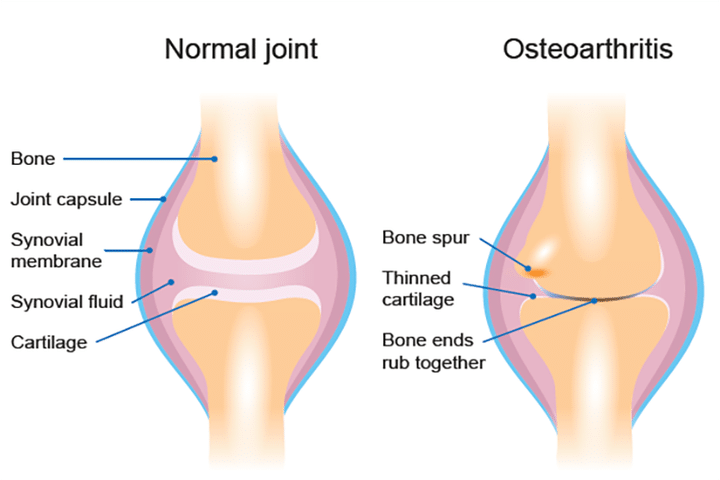Osteoarthritis - Homeopathy - Asian Homeocare
What is Osteoarthritis?
Osteoarthritis is the most common form of arthritis; it is a joint inflammation that results from cartilage degeneration. Cartilage is the slippery tissue that covers the ends of bones in a joint. Healthy cartilage absorbs the shock of movement. When cartilage is lost, bones rub together. Over time, this rubbing can permanently damage the joint. It is often called as wear-and-tear arthritis, as osteoarthritis occurs when the protective cartilage on the ends of your bones wears down over time.
Cause of Osteoarthritis
Degeneration of the cartilage results into Osteoarthritis, due to which it causes rubbing of bones and reduction of joint movement.
Few causes of Osteoarthritis are given below;
· Aging
· Joint Injury or trauma
· Muscle weakness
· Diabetes
· Overweight
· Inappropriate footwear (causing increased and imbalanced pressure on the knees)
· Hereditary
Risk Factors:
· Older age
· Having family members with OA
· Obesity
· Joint injury or repetitive use (overuse) of joints
· Joint deformities such as unequal leg length, bowlegs or knocked knees
· Presence of Gout, rheumatoid arthritis, septic arthritis or any other disease that affects bones or joints
Symptoms of Osteoarthritis
Common symptoms of Osteoarthritis are
· Pain: Your joint may hurt during or after movement.
· Tenderness: Your joint may feel tender when you apply light pressure to it.
· Stiffness: Joint stiffness may be most noticeable when you wake up in the morning or after a period of inactivity.
· Loss of flexibility: You may not be able to move your joint through its full range of motion.
· Grating sensation: You may hear or feel a grating sensation when you use the joint.
· Bone spurs: These extra bits of bone, which feel like hard lumps, may form around the affected joint.
· Swelling: There may be swelling and warmth and creaking of the affected joints.
· Exercise: Worsens after exercise and from putting weight on the joint
· Seasonal: It worsens in monsoon
· Mobility: Limited mobility of the joint
Diagnosis of Osteoarthritis
Physical examination:
· Swelling
· Tenderness
· Limitation of movements
· Grating sensation
Investigation and lab tests:
· X Ray
· Blood tests: To rule out any other causes of Joint pain such as Rheumatoid Arthritis.
Treatment of Osteoarthritis
Osteoarthritis treatment plans can involve:
· Exercise.
· Weight control.
· Rest and joint care.
· Nondrug pain relief techniques to control pain.
· Medicines.
· Complementary and alternative therapies.
· Surgery.
. Maintaining a healthy weight, exercising, and using special devices to help you get around can also have a big impact on your symptoms.
. Losing weight if you are overweight or obese can help take the pressure off your joints.
. People with gout should avoid alcohol and foods that are high in purines, and that includes organ meats (liver, kidney), dried beans, sardines, anchovies, asparagus, and mushrooms. When the body breaks down purines, it produces uric acid, and excess uric acid causes painful crystals to deposit in the joints. Making these changes may reduce flare-ups, but they almost never cure the condition
. Relieving Stiff Joints With Exercise
. When you’re in pain, the last thing you may want to do is exercise, but it’s actually one of the best things you can do for your joints. Aerobic, strength-training, and stretching exercises can all be helpful. Work with your doctor to learn what exercises are safe for you to do. Physical therapy is also a common part of treatment in people with OA. Regular exercise can also help you maintain a healthy weight.
Homeopathic treatment for Osteoarthritis
Homeopathy offers complete relief from all the symptoms of Osteoarthritis.
The medication can help in controlling pain as well as improving the mobility of the joints.
Most patients notice a reduction in the pain and stiffness after commencing treatment and improved mobility of the joints.
An overall general improvement in health is also noted by the majority of them
OA is a degenerative condition, it may not be possible to reverse the changes that have already occurred at the microscopic level on the joints but it is possible to slow down the further progress of the condition. In advanced cases, palliation is all that can be offered to the patients.
Also, it can prevent from complications which can occur in the condition like:
· Rapid, complete breakdown of cartilage resulting in loose tissue material in the joint (chondrolysis).
· Bone death (osteonecrosis).
· Stress fractures (hairline crack in the bone that develops gradually in response to repeated injury or stress).
· Bleeding inside the joint.
· Infection in the joint.
· Deterioration or rupture of the tendons and ligaments around the joint, leading to loss of stability.
· Pinched nerve (in osteoarthritis of the spine).



+1.svg)
